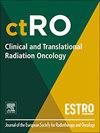乳腺癌放疗中靶体积的自动分割,对靶体积大小和危及器官剂量的影响
IF 2.7
3区 医学
Q3 ONCOLOGY
引用次数: 0
摘要
靶体积的划定在乳腺癌放疗计划中是至关重要的,但涉及到显著的观察者之间的可变性。深度学习(DL)模型可以减少这种可变性,节省时间和成本。然而,目前的dl模型没有考虑临床数据,如肿瘤位置和患者合并症,来调整靶点和减少危及器官(OAR)的剂量。本研究将临床定义的靶体积与dl模型生成的靶体积在大小、几何重叠和对OAR的剂量方面进行了比较。方法针对一例乳腺癌患者,比较瑞典放疗诊所和两种dl模型Raystation和MVision构建的靶体积。评估了几何重叠,以及靶区划分差异对OAR剂量的影响。制定局部与仅乳房3d适形放疗的治疗方案。结果乳腺、I-IV级淋巴结和乳腺内淋巴结分别有10个、11个和14个中心有sctv结构。ctv乳腺体积在770-890cc之间,ctv总体积(乳腺+淋巴结)在875-1003cc之间。dl模型不构成最大或最小的乳房或总ctv体积,结构之间的几何重叠相对较好。根据局部区域放射治疗的各自ctv体积评估剂量计划对OAR的剂量,这在dl模型和诊所产生的ctv平均值之间具有可比性。在仅对乳房进行放射治疗时,由dl模型构建的ctv乳房由于靠近胸壁,影响了场角的选择,因此心脏剂量最高。对同侧肺、甲状腺或肱骨头的剂量无差异。结论dl模型在目标圈定方面具有很大的潜力。然而,它们的引入必须密切监测,因为与临床标准相比,即使很小的差异也可能影响3D适形乳腺癌放疗的OAR剂量。本文章由计算机程序翻译,如有差异,请以英文原文为准。
Automated segmentation of target volumes in breast cancer radiotherapy, impact on target size and dose to organs at risk
Introduction
Target volume delineation is crucial in breast cancer radiotherapy planning but involves significant interobserver variability. Deep learning (DL) models may reduce this variability, saving time and costs. However, current DL-models do not consider clinical data, such as tumor location and patient comorbidity, to adjust the target and reduce dose to organs at risk (OAR). This study compares clinically defined target volumes to those generated by a DL-model in terms of size, geometric overlap, and dose to OAR.
Method
For a hypothetical breast cancer patient, we compared target volumes constructed by Swedish radiotherapy clinics and two DL-models, Raystation and MVision. Geometrical overlap was evaluated, as well as the impact of differences in target delineation on dose to OAR. Treatment plans for locoregional vs. breast-only 3D-conformal radiotherapy were generated.
Results
CTV-structures for the breast, lymph nodes level I-IV, and internal mammary nodes were available for 10, 11, and 14 centers respectively. Volume of the CTV-breasts varied between 770–890cc, and the total CTV-volumes (breast + lymph nodes) between 875–1003cc. The DL-models did not constitute the largest nor smallest breast or total CTV-volumes, and geometric overlap between structures was relatively good. Evaluating dose to OAR from dose plans based on the respective CTV-volumes for locoregional radiotherapy, this was comparable between the DL-models and the mean of the CTVs generated by the clinics. In radiotherapy of only the breast, the CTV-breasts constructed by the DL-models gave the highest heart doses due to their proximity to the chest wall, affecting field angle choices. No difference was seen in dose to the ipsilateral lung, thyroid gland, or humeral head.
Conclusion
DL-models for target delineation have great potential. However, their introduction must be closely monitored since even small differences compared to clinical standards may affect doses to OAR in 3D conformal breast cancer radiotherapy.
求助全文
通过发布文献求助,成功后即可免费获取论文全文。
去求助
来源期刊

Clinical and Translational Radiation Oncology
Medicine-Radiology, Nuclear Medicine and Imaging
CiteScore
5.30
自引率
3.20%
发文量
114
审稿时长
40 days
 求助内容:
求助内容: 应助结果提醒方式:
应助结果提醒方式:


